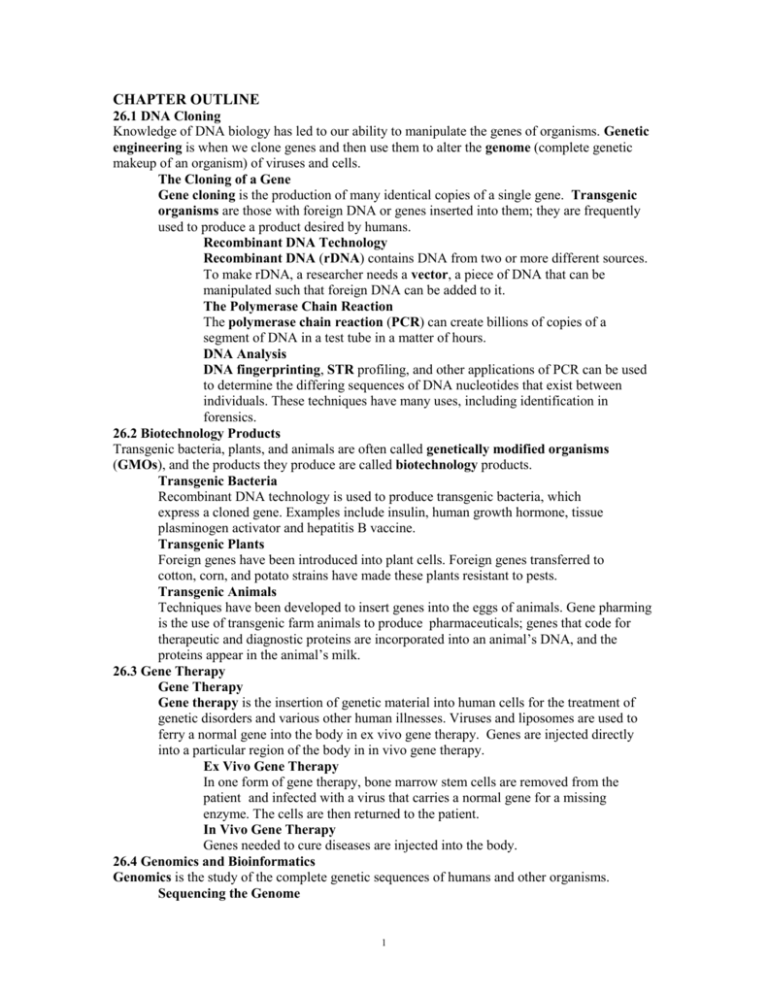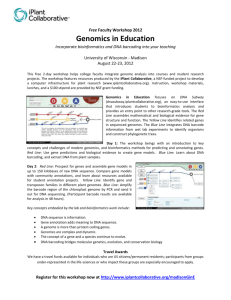CHAPTER OUTLINE
advertisement

CHAPTER OUTLINE 26.1 DNA Cloning Knowledge of DNA biology has led to our ability to manipulate the genes of organisms. Genetic engineering is when we clone genes and then use them to alter the genome (complete genetic makeup of an organism) of viruses and cells. The Cloning of a Gene Gene cloning is the production of many identical copies of a single gene. Transgenic organisms are those with foreign DNA or genes inserted into them; they are frequently used to produce a product desired by humans. Recombinant DNA Technology Recombinant DNA (rDNA) contains DNA from two or more different sources. To make rDNA, a researcher needs a vector, a piece of DNA that can be manipulated such that foreign DNA can be added to it. The Polymerase Chain Reaction The polymerase chain reaction (PCR) can create billions of copies of a segment of DNA in a test tube in a matter of hours. DNA Analysis DNA fingerprinting, STR profiling, and other applications of PCR can be used to determine the differing sequences of DNA nucleotides that exist between individuals. These techniques have many uses, including identification in forensics. 26.2 Biotechnology Products Transgenic bacteria, plants, and animals are often called genetically modified organisms (GMOs), and the products they produce are called biotechnology products. Transgenic Bacteria Recombinant DNA technology is used to produce transgenic bacteria, which express a cloned gene. Examples include insulin, human growth hormone, tissue plasminogen activator and hepatitis B vaccine. Transgenic Plants Foreign genes have been introduced into plant cells. Foreign genes transferred to cotton, corn, and potato strains have made these plants resistant to pests. Transgenic Animals Techniques have been developed to insert genes into the eggs of animals. Gene pharming is the use of transgenic farm animals to produce pharmaceuticals; genes that code for therapeutic and diagnostic proteins are incorporated into an animal’s DNA, and the proteins appear in the animal’s milk. 26.3 Gene Therapy Gene Therapy Gene therapy is the insertion of genetic material into human cells for the treatment of genetic disorders and various other human illnesses. Viruses and liposomes are used to ferry a normal gene into the body in ex vivo gene therapy. Genes are injected directly into a particular region of the body in in vivo gene therapy. Ex Vivo Gene Therapy In one form of gene therapy, bone marrow stem cells are removed from the patient and infected with a virus that carries a normal gene for a missing enzyme. The cells are then returned to the patient. In Vivo Gene Therapy Genes needed to cure diseases are injected into the body. 26.4 Genomics and Bioinformatics Genomics is the study of the complete genetic sequences of humans and other organisms. Sequencing the Genome 1 We now know the sequence of our genome due to the Human Genome Project. Genome Architecture Nearly 99% of the human genome is DNA that does not directly code for amino acid sequences. Transposons make up approximately 45% of the human genome and nearly half of the human genome is made up of repetitive elements. Redefining the Gene A gene is a genomic sequence (either DNA or RNA) directly encoding functional products, either RNA or protein. Functional and Comparative Genomics The genomes of many other organisms are also complete. Using comparative genomics, researchers have identified many similarities between the sequence of human bases and those of other organisms. The aim of functional genomics is to understand the function of the various genes discovered within each genomic sequence and how these genes interact. Proteomics Proteomics is the study of the structure, function, and interaction of cellular proteins. Bioinformatics Bioinformatics is the application of computer technologies to the study of biological information. 2









